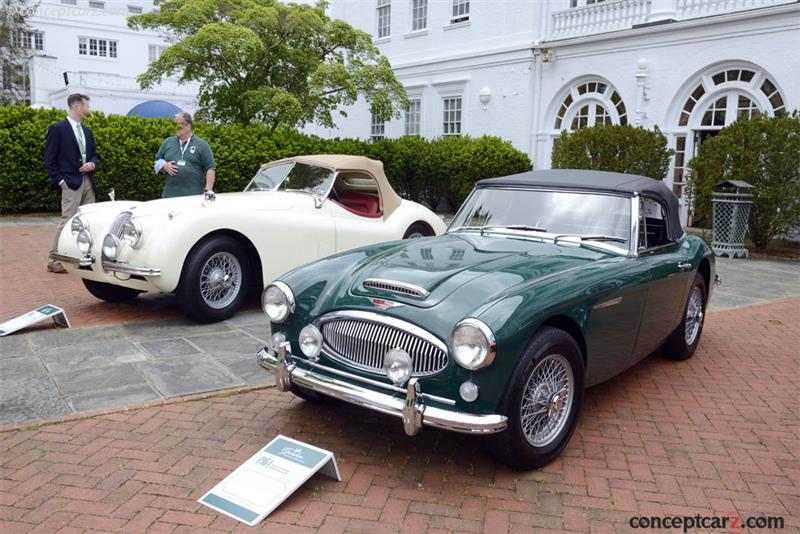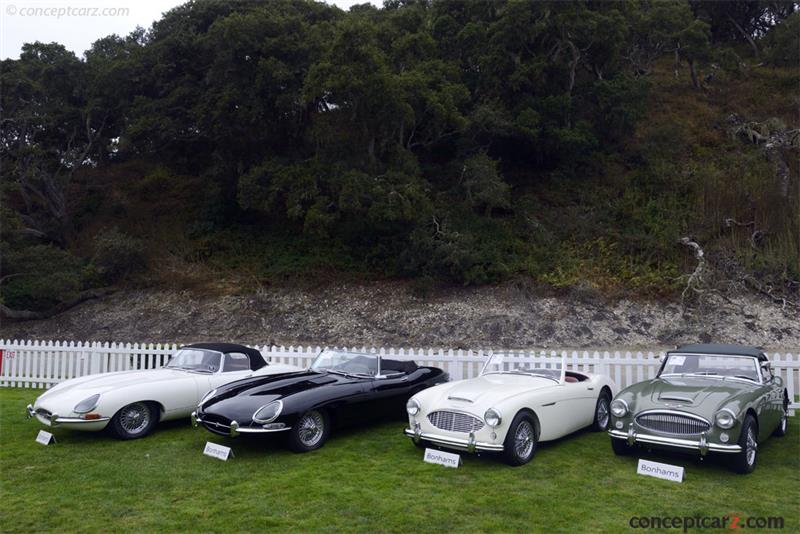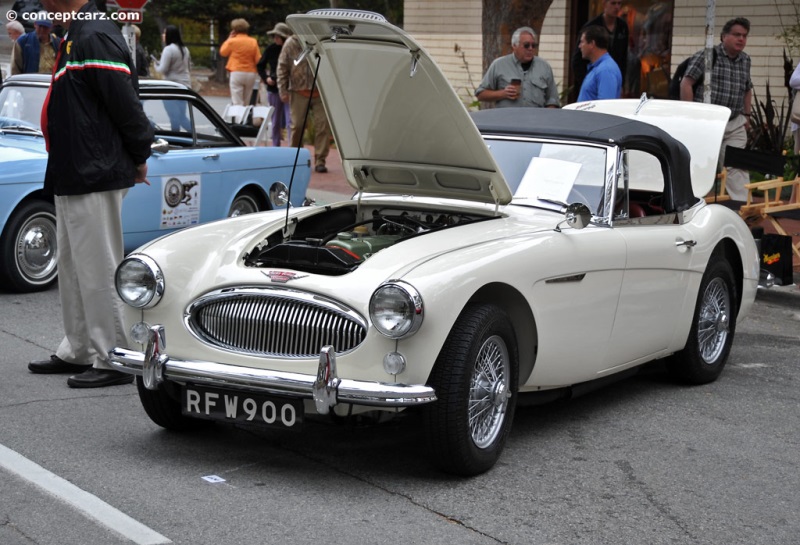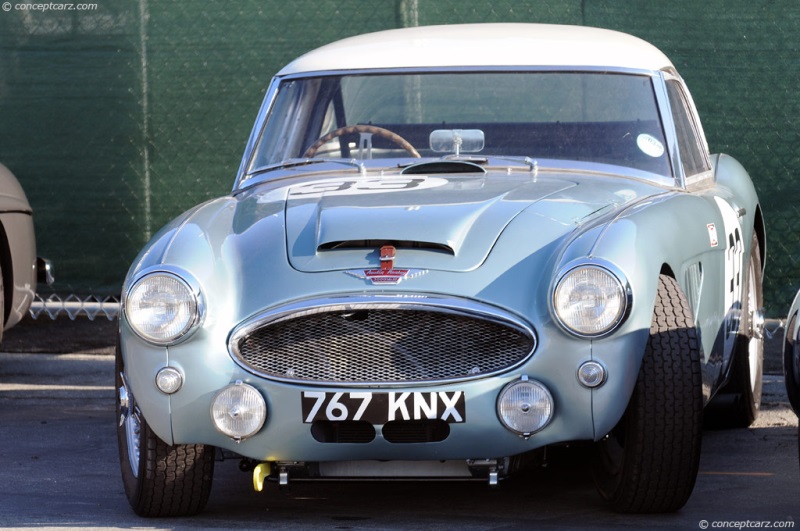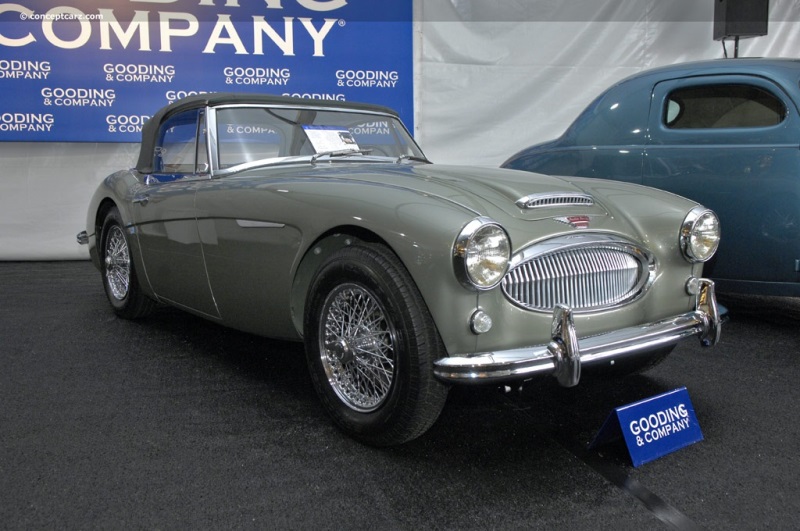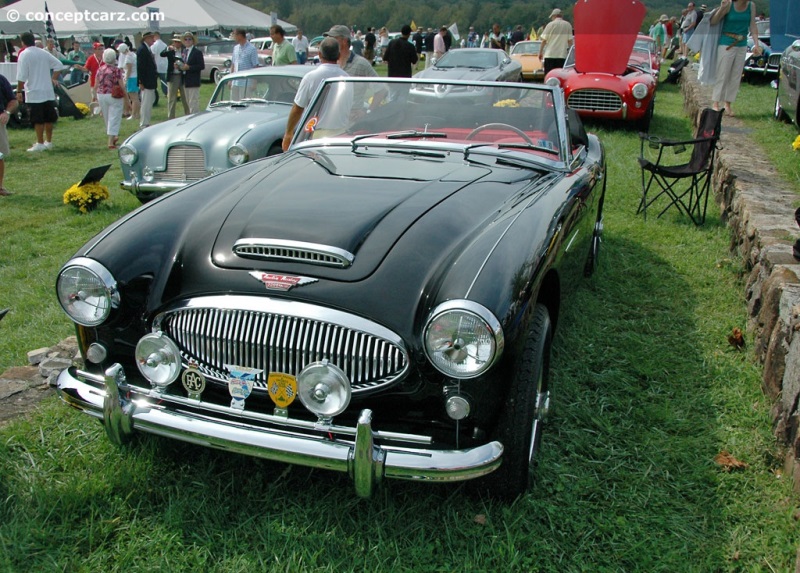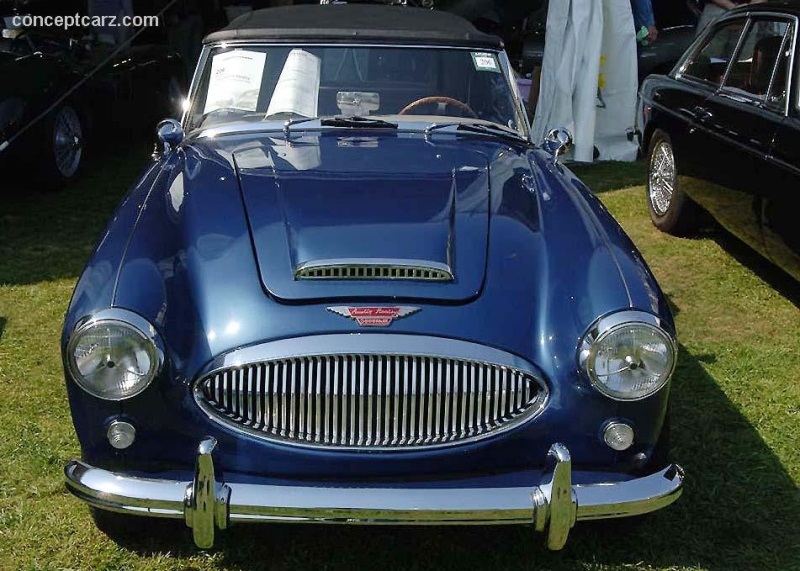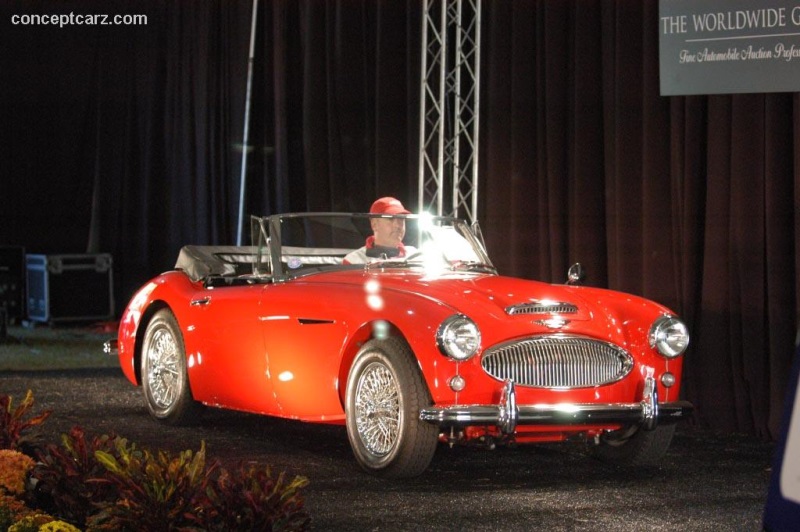Donald Healey built a reputation in the 1950s and early 1960s for his sports roadsters with competition potential. Healey was proficient in chassis engineering and forged relationships with various engine suppliers over the years, but none proved as successful as the collaboration with Austin that resulted in the Austin-Healey. The first model, the 100, was powered by a 2.6-liter inline-four-cylinder unit, that helped power the little roadster to success at its Le Mans debut in 1953 with a 12th-overall finish. 
Sport Convertible
Chassis #: HBJ8L25913
View info and history
Auction entries : 1The Austin-Healey proved popular with privateers and SCCA amateurs. It was consistently developed and updated, eventually being powered by a 3-liter six-cylinder engine.The Austin-Healey 100/6 was introduced for 1956 as a six-cylinder development of Donald Healey's ground-breaking Austin-Healey 100 roadster. Comprehensive refinement for 1959 brought about an enlarged 2,912cc engine, an improved gearbox, and disc brakes up front. Now designated the Austin-Healey 3000, the upgraded model was an immediate hit on the road and showroom floor. The Austin-Healey 3000 sports car was built from 1959 to 1967 and are the best known of the 'big' Healey models. Jensen Motors built the car's bodywork, and the vehicles were assembled at the BMC Abingdon works. The 3000 was raced with much success in many European rallies in its heyday and at most major racing circuits around the world, including Sebring, Le Mans, and Mount Panorama Circuit, Bathurst. The 3000 was successfully rallied by the BMC competitions department from its introduction, but the development of the works cars effectively ended in 1965, mainly because of the success of the Mini Cooper 'S'.The 3000 Mark III was launched in October 1963 and remained in production until the end of 1967 when production of Austin-Healey's ceased. This final and most refined version of the 3000 MK III (BJ8) series came with twin 2-inch SU carburetors, a new camshaft, valve springs, and a new design of the exhaust system helping the 2,912cc inline 'six' developed 148 horsepower and giving it a top speed above 120 mph. Other improvements included standard Servo-assisted power brakes, an upgraded cockpit with wood-faced dashboard and floor console, plus the roll-up side windows of the prior BJ7. The early production Mark III cars are known as 'Phase I' models and they featured much slimmer bodywork with smaller, single front sidelights and smaller rear lights versus the larger items on the later Phase II cars. Both Phase I and Phase II cars shared the same engine, wind-up windows, easy-up pram-style hood, and a walnut dash. The 'Phase 2' subvariant appeared soon after Mk III production commenced, delivering improved rear-suspension geometry, better ground clearance courtesy of exhaust-system tweaks, and enlarged twin parking and front turn-signal lights. Out of a total of 17,712 Mk IIIs (phase I and II), just 1,302 phase I cars were produced with over 90% due for export.The BMC Competitions Department prepared four Austin-Healey 3000 MkIIIs for the 1964 international rally season (chassis numbers 'ARX 91B', 'ARX 92B', 'BRX 852B', and 'BMO 93B.') Big Healey racing development had begun in 1958 with the 2.6-liter 100/6 model that debuted in that year's Monte Carlo Rally driven by Tommy Wisdom. The 2.9-liter 3000 model took over the racing duties mid-way through 1959. The 100/6 had proven to be very competitive and showed tremendous promise, achieving many leader-board finishes, the best of which was Jack Sears' class win in the 1959 Tulip Rally.Development was facilitated by the transfer of Austin-Healey production to MG's Abingdon factory in 1957 and the decision to base the works' rally program at the Competitions Department there under Marcus Chambers. Over the six years that followed, the 3000 was progressively developed and numerous upgrades and improvements were implemented. The program ended at the close of 1965 when the FIA's Appendix J regulations outlawed many of the special parts that had been homologated for competition use. The early 3000s models were powered by engines that employed the production version's cast-iron cylinder head and triple SU carburetors developing around 160 horsepower. One of the earliest modifications was the use of a short side-exit exhaust system, followed by fabricated tubular exhaust manifolds, aluminum cylinder heads, and triple Weber carburetors. These latter two modifications were introduced in 1962, and in its ultimate specification offered around 210 horsepower. The chassis of the Big Healey continued to use a separate chassis and body in traditional sports car fashion but welded together to increase rigidity and strength. Many of the body components, including the wings, bonnet, and doors were fabricated in aluminum rather than steel to save weight. The boot lid was also formed from aluminum and given a distinctive upward extension to accommodate twin spare wheels. The under-body received 'bash' plats to protect the low-slung surface and the car's limited ground clearance would prove to be among its Achilles heel, explaining the works' policy of running them 'nose up' to avoid grounding the sump. Another disadvantage was the lack of rear suspension travel which was not resolved until the introduction of dipped rear chassis rails from 1961, a modification that later found its way onto the 3000 MkIII Phase II production model. Other competition modifications included a limited-slip differential, close-ratio gears, and four-wheel disc brakes. Pat Moss and co-driver Ann Wisdom gave the Big Healey its first major racing success in 1960, finishing second in the Alpine and winning the Liège-Rome-Liège (Marathon de la Route) event outright. It was the first occasion that a woman had won a major international rally. The following year the Morley twins - Don and Erle - won the Alpine Rally outright, a feat they repeated in 1962. The Big Healey earned numerous class victories and many team awards. The car's final outright victories came in 1964 when Paddy Hopkirk won the Austrian Alpine Rally and Rauno Aaltonen the last Marathon de la Route held on public roads, which on this occasion followed a Spa-Sofia-Liège route.After the 1964 'Liège', Germany and Austria withdrew their permission for cars to run at unlimited speeds through their countries, bringing an end the original road race regulations. The grueling route traversed from Belgium through Germany, Austria, Italy, and several Adriatic countries before arriving in Bulgaria. After Italy, the roads became more treacherous and deteriorated dramatically, with potholes and loose rocks that punctured tires, damaged suspension, and ended many competitors' hopes of completing the route. After the spare tires were used, cars were sometimes driven on the wheel rims to reach the next service point. At Sofia, the halfway point, Rauno Aaltonen ('The Professor') was leading in 'BMO 93B', and despite many punctured tires held the lead to the finish. This was the fourth and final outright victory by an Austin-Healey on an international event forming part of the European Rally Championship, which prior to 1978 was the only FIA-approved championship for rally drivers.
by Daniel Vaughan | Jul 2020
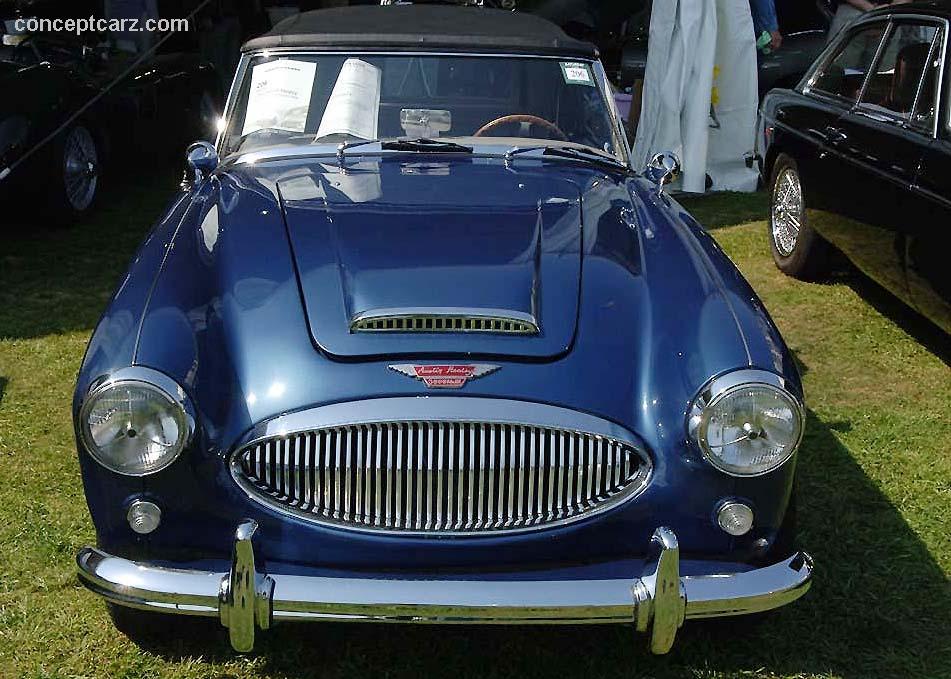
Sport Convertible
Chassis #: HBJ8L25913
View info and history
Auction entries : 1
by Daniel Vaughan | Jul 2020
Related Reading : Austin-Healey 3000 History
The Austin Healey 100 was introduced in October of 1952 at the Earls Court Motor Show. The first Austin Healey 100s were known as 100-4 or BN1. The name 100 came about by being able to break the 100 mph barrier. The BN also had meaning. The B represented the engine class which meant it had between 2000 and 3000 cc. The N represented the body-style configuration, two-seat and open-top. The 100 was....
Continue Reading >>
Continue Reading >>
Similarly Sized Vehicles
from 1964
Similarly Priced Vehicles
Mercury Park Lane ($3,350-$3,550)
Oldsmobile Dynamic Eighty-Eight ($2,925-$3,565)
Average Auction Sale: $70,195
Oldsmobile Dynamic Eighty-Eight ($2,925-$3,565)
Average Auction Sale: $70,195
1964 Austin-Healey 3000 MK III Vehicle Profiles
Recent Vehicle Additions
Performance and Specification Comparison
Price Comparison
3000 Mk III Specification Comparison by Year
Year
Production
Wheelbase
Engine
Prices
Related Automotive News

Gooding & Company Releases Entire Catalogue for Upcoming London Sale, Led by a 1953 Ferrari 166 MM/53 Spider Offered from Long-Term Ownership
The London Auction at Hampton Court Palace will present an unrestored Ferrari 166 MM53 Spider and Ferrari 250 Europa, as well as a desirable Fiat 8V Berlinetta and right-hand-drive Aston Martin DB5 Convertible.
Gooding %26 Company, the international...

Gooding & Company Presents the Best of American Motoring, from Brass Era Legends to Postwar Sports Cars, at Its Pebble Beach Auctions
An incredible 1912 Simplex 50 HP Toy Tonneau, offered for sale from 111 years of single family ownership, will come to market for the first time, alongside motoring icons from the greatest eras of American automotive history.
The official auction...

A New Automotive Icon To Debut At Le Mans – First DB4 GT Zagato Continuation Set For Unveil At Circuit De La Sarthe
DB4 GT Zagato Continuation to make public debut at 24 Hours of Le Mans 2019
Race-goers will be first to see Aston Martins most expensive new car
DB4 GT Zagato Continuation extends Zagato bloodline in centenary year
11 June 2019, GaydonLe Man...

Rally And Racing Cars Set The Pace At Bonhams Goodwood Revival Sale
An impressive array of sporting classic and collectors motor cars will be offered at Bonhams Goodwood Revival Sale on 9 September, including the collection of the inaugural British Saloon Car Championship winner, Jack Sears.
Also offered is...

FCA Stars In The Goodwood Festival Of Speed 2017
From 29 June to 2 July, West Sussex will host one of the most prestigious events of international motor sports – Goodwood Festival of Speed 2017. Making an appearance will be rare classic Alfa Romeo, Abarth, Lancia and Fiat cars, along with the latest...























